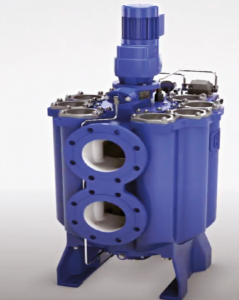The Charity
Aviation
Maritime
Personal injury – Burn to body and face

Initial Report
Brief account of incident
The vessel was alongside the berth. At 15.50 engineers started the removing the cover of the main engine fuel oil filter filter. Hot fuel sprayed onto the body and face of one of the engineers who was transferred to the ship’s hospital for immediate medical attention, while urgent transportation to hospital ashore was arranged. The engineer was hospitalized locally for a week and then repatriated. According to the final medical report issued two weeks later, the engineer was recovering well but his condition would need to be re-evaluated in a month’s time.

A Typical modern Fuel Oil Back flush filter
Incident investigation
The investigation noted that an on-board risk assessment had been issued but it had not been forwarded to the company for review and endorsement. It did not address all of the potential hazards. A toolbox meeting was
held before the work was started, and both the supervisor and the injured junior engineer had undertaken the same task previously.
A review of the work/rest hours revealed that the injured crew member was well rested and his working hours were with in company and MLC requirements. A Permit to Work had been issued and all involved crew members were wearing the correct PPE.
It appears the incident occurred due to inadequate implementation of the Company’s basic safety procedures.
The filters were not isolated properly from the compressed air pipe and the isolation valves were not labelled as closed as required by the relevant work permit.
The filters were not checked for being under pressure and draining of the filter was not carried out prior to opening the cover.
The maker’s safety instructions were not followed.
Lessons learned
Every non-routine work activity needs adequate and proper planning, detailed hazards identification and comprehensive risk controls to be carried out safely and effectively.
A toolbox meeting should always take place at the work site prior to every job, covering hazards involved and the necessary preventive measures, work permits, risk assessments should be considered/ discussed during the meeting.
Proper supervision is an important safety factor during on board activities. The supervisor has a duty to ensure that safety instructions and good seamanship practices are always implemented and to prevent potential unsafe acts or omissions that may lead to injury or damage.
Maintenance activities on equipment or machinery under pressure involve several hazards and risks that could lead to severe injury if they are not properly addressed.
A thorough and effective risk assessment must always be diligently carried out, whilst the company’s work permit system procedures must be strictly followed.
Personnel involved must be effectively briefed in detail to ensure that they are fully aware of the hazards involved and risk control measures which should be implemented prior, during and after the work activity.
The recommendations and guidance of the makers of the systems must always be followed at every stage of the work activity.
CHIRP Comments
This lost work case injury was avoidable if proper procedures had been in place before the work started. The key hazards are pressurised hot oil and internal pollution. All attention should have gone into ensuring that these hazards were eliminated before undertaking the work.
In this instance, the pressure in the system was not relieved before lifting the filter covers.
The two engineers had the necessary experience to carry out this work and had done so before. There would appear to be an element of complacency and possible lack of teamwork before the job commenced. Further, given the time of the day that the work commenced, there could have been some time pressure.
The ISM Code demands that the safety management objectives of the company should assess all identified risks to its ships, personnel and the environment and establish appropriate safeguards.
The risk assessment used was inadequate and, as the investigation points out, did not identify the risks. Furthermore, it was not submitted to the company for review. If a permit to work system was used for working on a hot oil pressurised system and it was followed properly it would have identified the hazards and they could have been eliminated. Approximately half of the manufacturer’s instructions were not followed. Why?
CHIRP feels that the permit to work (PtW) system was not fit for purpose and should be revised. If a PtW is too complex it is difficult to follow, and short cuts may be taken. If it is not used, then it points to serious failings in the company’s safety culture.
CHIRP notes that the corrective and preventative actions proposed by the company were very detailed so it would be very easy to assume that there was complacency and time pressure which could be part of the problem. However, the root cause could be something more fundamental relating to the company’s overall safety culture. The crew never set out to injure themselves, but it happened anyway!
Human factors relating to this report
Culture – Does your company, vessel or team have a ‘Just’ culture? If not, records could be falsified to indicate compliance because seafarers are afraid of the repercussions of reporting inadequate procedures or practices.
Local practices – Do not allow ‘local’ practices replace standard or ‘best’ practice.
Pressure – Do not let pressure lead to your taking short cuts.
Capability – Are crew members adequately trained and briefed to undertake safety critical tasks? Are toolbox meetings held and properly conducted?
Alerting – Report inadequate procedures or inspections so that they can be improved. Be assertive – it can save lives.
Report Ends………….







